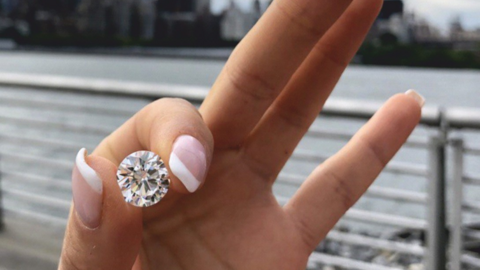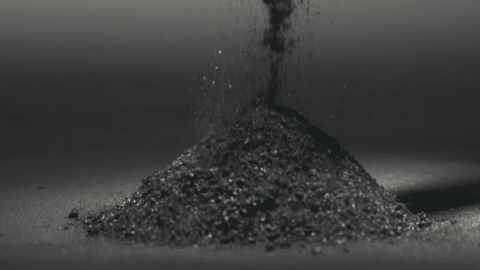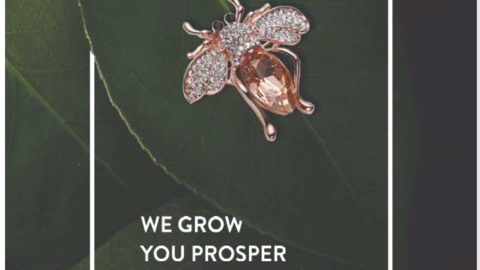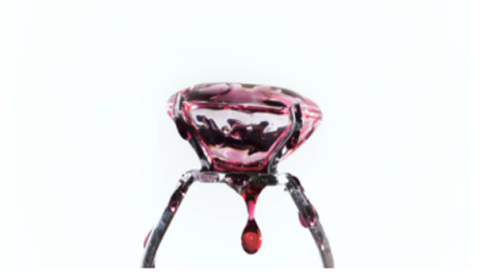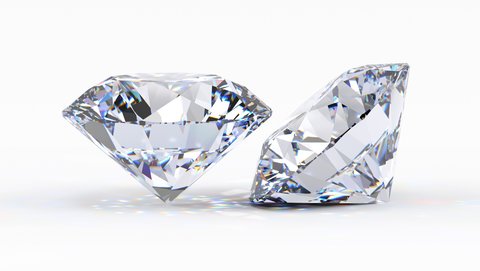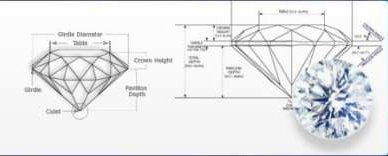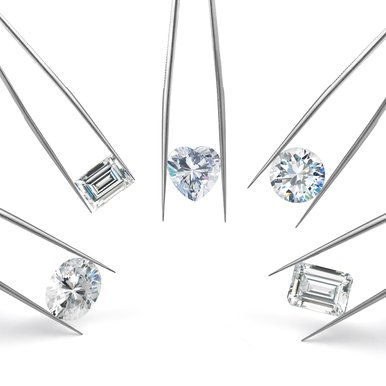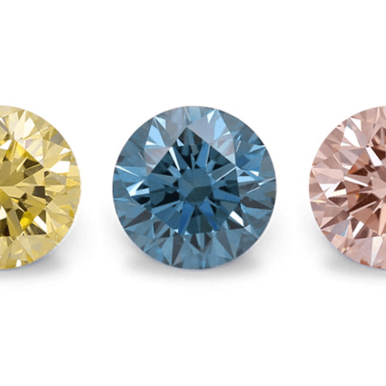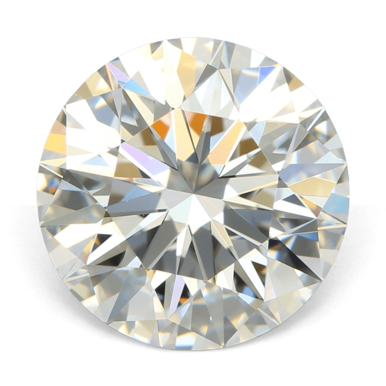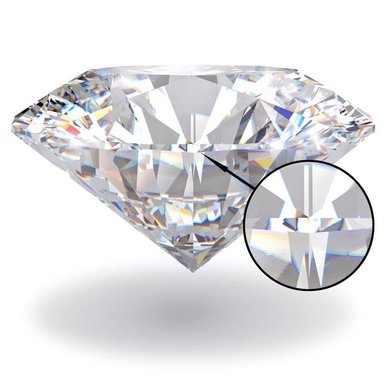The Ultimate Guide to F Color Diamonds: Premium Quality at Exceptional Value
1. Introduction to F Color Diamonds
When searching for the perfect diamond, color is one of the most critical factors that determines both beauty and value. F color diamonds hold a special place in the diamond world as the final grade in the prestigious "colorless" range on the GIA scale. These exceptional gems offer a perfect balance between the premium appearance of higher color grades and better value compared to D and E diamonds.
F color diamonds are prized for their icy white appearance that appears completely colorless to the naked eye. For discerning buyers seeking top-tier quality without paying the premium for D or E color stones, F color diamonds represent an excellent sweet spot in the market. They're particularly sought after for engagement rings and other significant jewelry pieces where quality and brilliance are paramount.

2. Understanding Diamond Color and the GIA Scale
Diamond color might seem straightforward, but it's actually one of the most nuanced qualities that affects a diamond's appearance and value. The Gemological Institute of America (GIA) established the definitive diamond color grading system that ranges from D (completely colorless) to Z (light yellow or brown). This alphabetical scale has become the industry standard worldwide for assessing diamond color.
The colorless category includes only three grades: D, E, and F. While D represents absolute colorlessness, F color diamonds sit at the lower end of this elite colorless range. When examined by expert gemologists under controlled lighting conditions and compared against master stones, F color diamonds reveal just the faintest hint of color—imperceptible to the untrained eye in real-world settings.
The color assessment process is incredibly precise, with diamonds being evaluated face-down against a white background under standardized lighting. This meticulous approach ensures that even the most subtle color differences between grades can be consistently identified by trained professionals.
3. Unique Features of F Color Diamonds
F color diamonds possess several distinctive characteristics that make them highly sought-after in the diamond market. First and foremost, these gems appear completely colorless to the naked eye. Only expert gemologists with specialized equipment can detect the extremely subtle hint of color that differentiates them from perfect D color diamonds. This visual colorlessness is what places F diamonds within the coveted "colorless" category alongside D and E grades.
What makes F color diamonds particularly special is their perfect balance of quality and value. They belong to the prestigious DEF group—a collection of diamonds considered investment-worthy due to their rarity and exceptional appearance. Natural F color diamonds comprise only a small percentage of all diamonds mined worldwide, making them considerably scarcer than lower color grades.
When well-cut, F color diamonds display remarkable brilliance and sparkle. Their near-perfect optical properties allow them to reflect and refract light exceptionally well, creating that coveted fire and scintillation that diamond lovers seek. The minimal color in F diamonds means there's virtually nothing to diminish their ability to return light to the viewer's eye, especially when paired with excellent cut quality. This combination of rarity, colorless appearance, and exceptional light performance makes F color diamonds a premium choice for discerning buyers who want the best balance of quality and value.
Unique Features of F Color Diamonds
Visually Colorless
Appears completely colorless to the naked eye.
Only detectable by expert gemologists using specialized equipment.
Rare & Valuable
Part of the exclusive DEF investment-worthy group of diamonds.
Limited natural supply with premium market positioning.
Exceptional Brilliance
When well-cut, delivers remarkable sparkle and light performance.
Minimal color means maximum light return to the eye.
Perfect Balance of Quality & Value
Premium colorless appearance without paying
the highest price for D or E diamonds
4. F Color vs Other Diamond Colors (D, E, G, H, etc.)
When selecting a diamond, understanding how F color compares to other grades on the GIA scale can help you make an informed decision that balances quality and value. Let's examine how F color diamonds stack up against both higher and lower color grades.
F vs D and E Colors
The differences between F and higher colorless grades (D and E) are incredibly subtle. Even professional gemologists need specialized equipment and controlled lighting to distinguish between these top colorless grades. In practical terms:
- Visual Appearance: When set in jewelry and viewed with the naked eye, F diamonds are indistinguishable from D and E diamonds. The distinction becomes visible only under magnification or specialized diamond grading conditions.
- Price Difference: F color diamonds typically cost 10-15% less than D color diamonds of equivalent specifications, making them a more cost-effective choice for a visually identical stone.
- Rarity Factor: While all colorless diamonds are rare, D diamonds are slightly rarer than F, which is reflected in their price premium rather than their visible beauty.
F vs G, H, and Lower Grades
The distinction between F and lower grades becomes more noticeable:
- Category Distinction: F is the final grade in the "colorless" category, while G begins the "near-colorless" range. Though G and H diamonds still appear colorless to most observers, experts can detect faint warmth, especially in larger stones.
- Setting Considerations: G and H diamonds may show a slight tint in certain settings, particularly when placed next to higher color grades. F diamonds maintain their icy appearance regardless of setting or stone size.
- Value Proposition: The price difference between F and G grades (approximately 8-12%) is less than between D and F, yet the visible difference is more perceptible in certain circumstances.
Diamond Color Grades Comparison
| Color Grade | Category | Visible Color | Best For | Relative Price |
|---|---|---|---|---|
| D | Colorless | None | Perfectionists, investment | Highest (100%) |
| E | Colorless | None to naked eye | Luxury buyers | -5-8% from D |
| F | Colorless | None to naked eye | Value-conscious quality buyers | -10-15% from D |
| G | Near-Colorless | Faint tint (expert eye) | Balanced budget/quality | -20-25% from D |
| H | Near-Colorless | Slight warmth (expert eye) | Budget-conscious buyers | -30-35% from D |
| I-J | Near-Colorless | Detectable tint (trained eye) | Maximum size for budget | -40-50% from D |
This comparison illustrates why F color diamonds are often considered the ideal balance between premium quality and sensible value, offering truly colorless beauty without the premium price of D diamonds.
Would you like me to continue with the next section on price, value, and investment potential of F color diamonds?
5. Price, Value, and Investment Potential
F color diamonds offer a compelling value proposition within the diamond market, striking an impressive balance between quality and cost. Understanding their pricing structure and long-term value can help you make an informed investment decision.
Price Considerations
F color diamonds generally cost about 10-15% less than D color stones with identical specifications (cut, clarity, and carat). This price difference represents significant savings without any visible compromise in beauty. For example, a 1-carat F color diamond might cost $7,000-$8,000, while a comparable D color diamond could cost $8,500-$9,500, depending on other quality factors.
The price advantage becomes even more pronounced when comparing F to G color diamonds, which typically sell for about 8-12% less than F. This pricing cascade reflects the market's valuation of the technical colorless designation, even when the visual differences are minimal in real-world settings.
Value for Money
F color diamonds are widely considered an excellent value proposition for several reasons:
- They deliver the coveted "colorless" classification without the premium price of D or E diamonds
- They maintain their icy white appearance in all settings and lighting conditions
- They offer better resale value than lower color grades due to their position in the colorless range
- They provide flexibility in selecting other important diamond characteristics (cut, clarity, carat) while staying within budget
Investment Potential
Within the diamond investment landscape, F color diamonds hold a strong position. As part of the exclusive DEF colorless group, they tend to maintain value better than lower color grades. Their investment advantages include:
- Consistent demand in the luxury jewelry market
- Relative rarity compared to near-colorless grades
- Strong performance in the secondary market and at auction
- Appeal to both retail and wholesale buyers
For those considering diamonds as part of an investment strategy, F color stones present an opportunity to acquire investment-grade quality with more efficient capital allocation than D or E colors.
Lab-Grown D Color Diamonds Collection
| SHAPE | CARAT | CUT | COLOR | CLARITY |
|---|
Register on our website to gain access to our complete diamond database.
Sign up6. Choosing the Right Clarity and Cut for F Color Diamonds
Selecting the perfect F color diamond involves more than just focusing on color grade. The synergy between color, clarity, and cut dramatically affects a diamond's overall appearance and value. Here's how to optimize your selection:
The Critical Importance of Cut Quality
For F color diamonds, cut quality is paramount. A superior cut maximizes the diamond's ability to reflect light, creating exceptional brilliance and fire that enhances its colorless appearance:
- Excellent or Ideal Cut: Prioritize excellent to ideal cut grades for F color diamonds to maximize light performance. A well-cut F color diamond will appear brighter and more colorless than a poorly cut higher color grade.
- Proportions Matter: Look for optimal table percentages (56-59%), depth percentages (59-62%), and symmetry grades (excellent) to ensure maximum brilliance.
- Light Performance: When paired with excellent cut quality, F color diamonds display exceptional fire and scintillation that can make them indistinguishable from higher color grades.
Recommended Clarity Grades
To complement the premium colorless quality of an F color diamond, certain clarity grades work best:
- VS2 or Better: For F color diamonds, clarity grades of VS2 or higher are typically recommended to ensure the diamond appears as clean as its color. This ensures no visible inclusions detract from the colorless appearance.
- SI1 for Smaller Stones: For diamonds under 1 carat, SI1 clarity can be eye-clean while offering better value, allowing you to prioritize cut quality.
- Eye-Clean Priority: Always prioritize diamonds that are "eye-clean" regardless of technical grade. Some VS2 diamonds may have visible inclusions while some SI1 diamonds appear flawless to the naked eye.
Balancing the 4Cs for Optimal Value
Finding the sweet spot between cut, clarity, color, and carat requires strategic compromises:
- Prioritize Cut: Never compromise on cut quality for an F color diamond – a poorly cut diamond will not display its colorless properties effectively.
- Size Considerations: As diamonds increase in size, color becomes more visible. For diamonds 2 carats and larger, F color becomes increasingly valuable compared to near-colorless grades.
- Budget Allocation: When working with a set budget, allocate more toward cut quality and slightly less toward clarity if necessary. A VS2-SI1 F color with excellent cut will typically appear more beautiful than a VVS1 F color with good cut.
7. Best Settings and Metal Choices for F Color Diamonds
F color diamonds offer remarkable versatility when it comes to settings and metal choices. Their colorless nature allows them to shine brilliantly in virtually any setting, though certain combinations particularly enhance their icy white appearance.
Optimal Metal Choices
While F color diamonds look stunning in any metal, certain choices can maximize their colorless appearance:
- Platinum: The ultimate complement to F color diamonds, platinum's naturally white hue enhances the diamond's colorless quality. Its dense, lustrous finish creates a sophisticated backdrop that allows the diamond's brilliance to take center stage.
- White Gold: 14k or 18k white gold settings provide an excellent, more affordable alternative to platinum while still highlighting the colorless nature of F diamonds. The rhodium plating on white gold creates a bright white finish that beautifully complements the diamond.
- Yellow or Rose Gold: Unlike lower color grades (H and below) that might appear more tinted against yellow gold, F color diamonds remain visibly colorless even in warm-toned metals. This versatility makes F color diamonds adaptable to any design style or metal preference.
Setting Styles That Enhance F Color
Certain setting styles particularly showcase the exceptional quality of F color diamonds:
- Solitaire Settings: Minimalist solitaire settings allow maximum light to enter the diamond, highlighting the superior light performance of colorless F diamonds.
- Halo Settings: The small accent diamonds surrounding the center stone create a stunning contrast that enhances the perceived size and brilliance of an F color center diamond.
- Three-Stone Settings: When flanked by slightly lower color side stones (G-H), an F color center diamond appears even more brilliant by comparison.
Side Stones and Pavé Considerations
When selecting accent diamonds to complement an F color center stone:
- Same-Color Matching: For maximum luxury appearance, matching F color accent stones create a consistently icy look.
- Strategic Downgrading: G or H color accent stones can be used without visible color difference, providing cost savings while maintaining a cohesive appearance.
8. Natural vs Lab-Grown F Color Diamonds
The choice between natural and lab-grown F color diamonds represents one of the most significant decisions in today's diamond market. Both options offer the coveted colorless appearance of F grade diamonds, but they differ considerably in various aspects.
Appearance Comparison
In terms of visual appearance, lab-grown and natural F color diamonds are virtually identical:
- Physical Properties: Both types possess the same crystal structure, optical properties, and chemical composition (pure carbon).
- Expert Assessment: Even professional gemologists require specialized equipment to distinguish between them.
- Color Consistency: Lab-grown F color diamonds often exhibit exceptional color consistency, sometimes with fewer secondary hues than their natural counterparts.
Price Differences
The most dramatic distinction between natural and lab-grown F color diamonds is their price:
- Cost Savings: Lab-grown F color diamonds typically cost 50-70% less than their natural counterparts with identical specifications.
- Value Example: A 1-carat, VS1 clarity, excellent cut natural F color diamond might cost $7,000-$8,000, while a lab-grown equivalent often sells for $3,000-$4,000.
- Size Advantage: The significant price difference allows buyers to purchase larger, higher-quality lab-grown diamonds within the same budget.
Market Trends and Consumer Preferences
Lab-grown F color diamonds have gained remarkable market traction in recent years:
- Growing Popularity: The lab-grown diamond market share has expanded dramatically, with F color being among the most popular choices.
- Environmental Considerations: Many consumers choose lab-grown F color diamonds for their reduced environmental footprint compared to mined diamonds.
- Millennial Appeal: Younger buyers increasingly prefer lab-grown options that align with their values while delivering identical beauty.
FAQ about D color Lab-Grown Diamonds
Yes, F color diamonds are generally worth the premium over G color for those who value truly colorless diamonds. While the price difference is typically 8-12%, F diamonds are officially "colorless" while G diamonds are "near-colorless," which can make a visible difference in larger stones and certain settings, particularly platinum and white gold.
No, the average person cannot see any difference between F and D color diamonds when viewed in a normal setting. Only trained gemologists using controlled lighting and comparison stones can detect the subtle differences between these colorless grades. This is why many experts consider F color diamonds the better value proposition.
VS2 is generally considered the ideal clarity grade to pair with an F color diamond. This combination provides a diamond that appears flawless to the naked eye while maintaining the premium colorless appearance, offering the best balance of quality and value.
Yes, within the lab-grown diamond market, F color diamonds tend to maintain their value better than lower color grades. While all lab-grown diamonds experience different market dynamics than natural diamonds, the premium colorless grades (including F) consistently command higher resale values and better market liquidity.
Unlike lower color grades, F color diamonds remain colorless in virtually all lighting conditions. Their position in the colorless range means they don't contain enough yellow or brown tint to become visible even in warm lighting environments like candlelight or sunset, which is a significant advantage over G-J color diamonds.
Medium to strong fluorescence can actually be beneficial in F color diamonds, potentially making them appear whiter in natural daylight. While fluorescence can reduce the price of an F color diamond by 5-15%, it rarely affects transparency or brilliance at this color grade, making fluorescent F diamonds an excellent value opportunity.
Surprisingly, F color diamonds maintain their colorless appearance even in vintage-style yellow gold settings. While many assume yellow gold requires higher color grades, the technical colorlessness of F diamonds means they remain visibly white even against warm-toned metals, allowing more versatility in setting choices than G-J diamonds.
Round brilliant cuts showcase F color quality best due to their superior light return. Step cuts like emerald and asscher may require higher color grades (D-E) as they tend to retain more color. Fancy shapes like oval and pear fall in between, with F color offering excellent performance while masking slight color better than step cuts.


